India E-Commerce Market Size
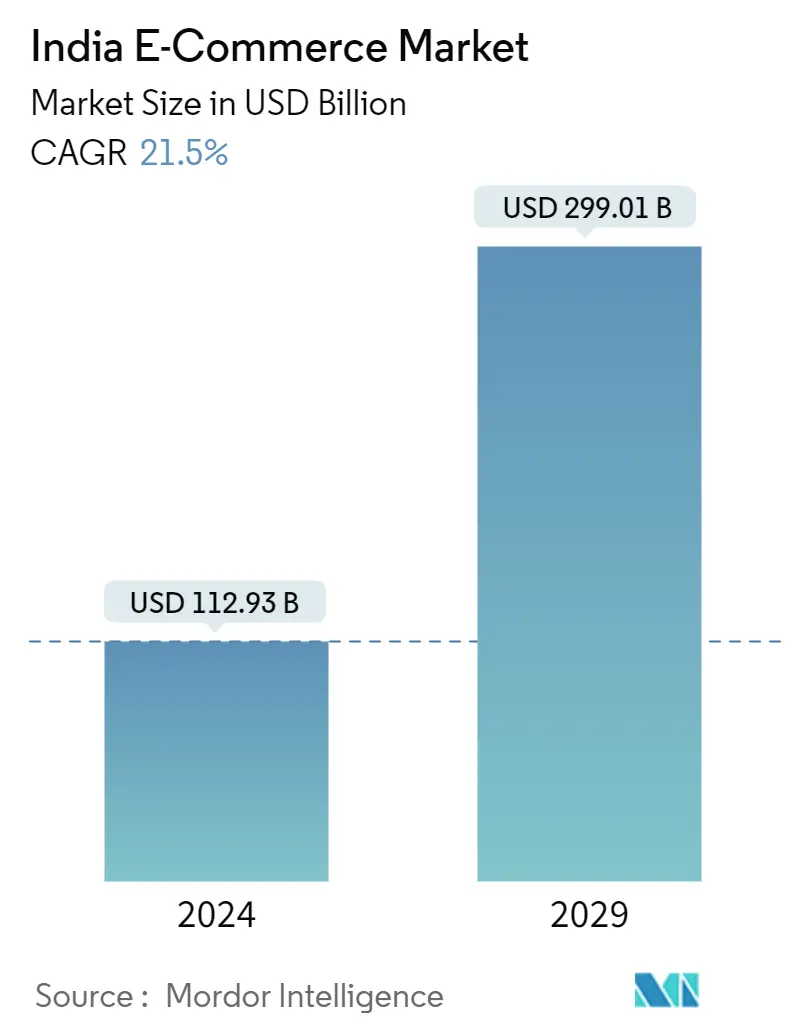
| Study Period | 2019 - 2029 |
| Base Year For Estimation | 2023 |
| Market Size (2024) | USD 112.93 Billion |
| Market Size (2029) | USD 299.01 Billion |
| CAGR (2024 - 2029) | 21.50 % |
| Market Concentration | Medium |
Major Players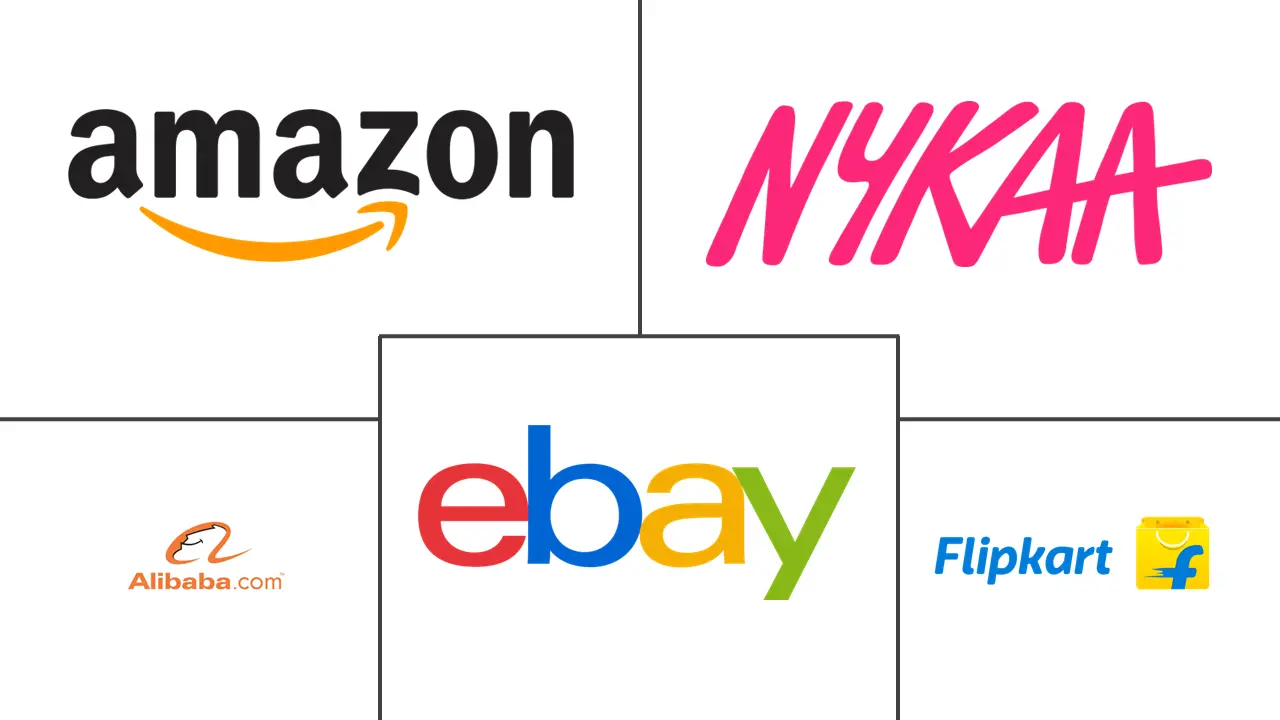
*Disclaimer: Major Players sorted in no particular order |
India E-Commerce Market Analysis
The India E-Commerce Market size is estimated at USD 112.93 billion in 2024, and is expected to reach USD 299.01 billion by 2029, growing at a CAGR of 21.5% during the forecast period (2024-2029).
One of the primary factors driving the market's growth is rapid urbanization. Additionally, rising internet penetration and devices such as smartphones, laptops, and tablets to access e-commerce websites boost the market's growth. E-commerce allows businesses to conduct business without maintaining a physical presence, saving money on infrastructure, communication, and overhead.
- The policies introduced by the Government of India, including 100% FDI in B2B E-commerce through the automatic route in the marketplace model of B2C E-commerce, are projected to boost the sector's growth. As per the new FDI policy, online entities, through foreign investment, cannot offer the products sold by retailers in which they hold an equity stake.
- According to the India Brand Equity Foundation (IBEF), the Indian government's Digital India effort aims to drive it into an online economy worth trillions by 2025. It has led to the formation of a new steering group to review and analyze the development of an e-commerce platform for the government.
- The commerce ministry has started a new committee to review the Open Network for Digital Commerce (ONDC) strategy. ONDC is an e-commerce platform that the government is supporting and aims to provide the final shop's infrastructure, which will resemble Flipkart and Amazon. Such developments are expected to drive the studied market.
- According to IBEF, by 2024, online retail penetration will reach 10.7%, up from 4.7% in 2019. Likewise, by 2025, India's internet buyers will number 220 million. According to a Payoneer report, India's e-commerce sector is ranked 9th in the world for cross-border growth. E-commerce in India is expected to grow from 4% of total food and groceries, fashion, and consumer electronics retail sales in 2020 to 8% by 2025.
- Expansion of e-commerce can raise competition in retail markets, increase consumer choice, and motivate and expedite product distribution innovation. However, several competition agencies' recent enforcement and advocacy work have revealed the possibility of anticompetitive behavior in the internet context. Concerns about potential market fragmentation are significant among many organizations that have looked into the topic of e-commerce competition.
- The pandemic-induced lockdown and mobility restrictions represented a significant point for e-commerce in India, driving demand to new highs, bringing new shoppers and sellers into digital platforms, and offering players long-term growth. Containment efforts introduced people to the convenience of online buying and motivated online buyers to buy more, making the Indian e-commerce business one of the significant beneficiaries of the pandemic.
India E-Commerce Market Trends
Internet Plays a Significant Role in Market Growth
- As per IBEF, internet and smartphone usage has fueled most of the industry's expansion. Because of the 'Digital India' campaign, internet connections expanded dramatically to 850 million in 2022. According to TRAI, as of September 2022, rural internet subscribers were over 343.8 million in India and 507.8 million in its urban counterpart.
- According to TRAI, in 2022, India had over 1020.91 million wireless mobile subscribers. The majority of traffic that year came from a 4G data payload.
- Due to a lack of confidence and security concerns with internet payments, cash payments have traditionally been the favored payment method in India. However, digital payments are predicted to account for 80% of all transactions in India by 2025 due to a large young population with smartphone access. The Indian market has been adopting digital eWallets quicker than the United States, the United Kingdom, and China, according to ASSOCHAM (the Associated Chambers of Commerce and Industry).
- Presently, 5G is among the most invested technologies by several end-user industries in the market. 5G connectivity further opens up various use cases in increasing the efficiency of varied sectors. With the growing proliferation of technology in smartphones, consumers are increasingly expecting digital engagement and personalized experiences overall.
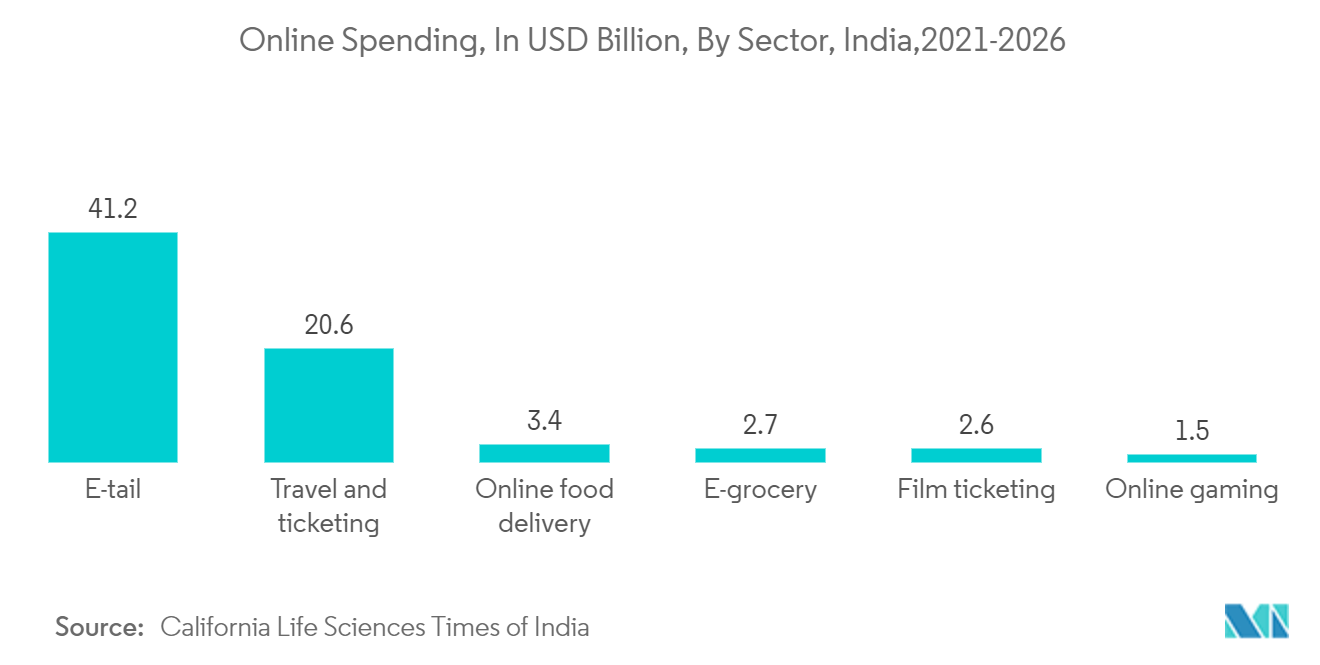
Consumer Electronics is a Strong Contributor to the Market's Growth
- E-commerce companies recorded significant consumer electronics sales across platforms due to increased buying during the holiday season. Flipkart Group emerged as one of the prominent players with intensifying competition from Amazon throughout the festive season in the country.
- India's refrigerator, washing machine, and air conditioner markets held a significant market share, with washing machines leading. According to the India Cellular & Electronics Association (ICEA), India's laptop and tablet manufacturing industry could be worth USD 100 billion by 2025. Such a massive increase in the consumer electronics market may allow Indian e-commerce players to increase their online product line. It may open new online sites specific to the consumer electronic market.
- By creating an electronic components manufacturing base in India and boosting exports, IT companies focus on entering the Indian consumer electronics market. Consumer electronics companies are focusing on the smart wearables sector in India. According to FDI India, by 2025, the Indian Electronics Manufacturing Service (EMS) industry is estimated to have grown 6.5 times from USD 23.5 billion to USD 152 billion.
- India is expected to exhibit remarkable growth in the soundbar segment. Factors such as increasing disposable income and features, such as high-definition (HD) smart TVs with built-in Wi-Fi for connectivity to Netflix, Amazon Prime, and YouTube, among other online streaming channels, significantly increase consumer spending on these devices. Such trends may drive the studied market.
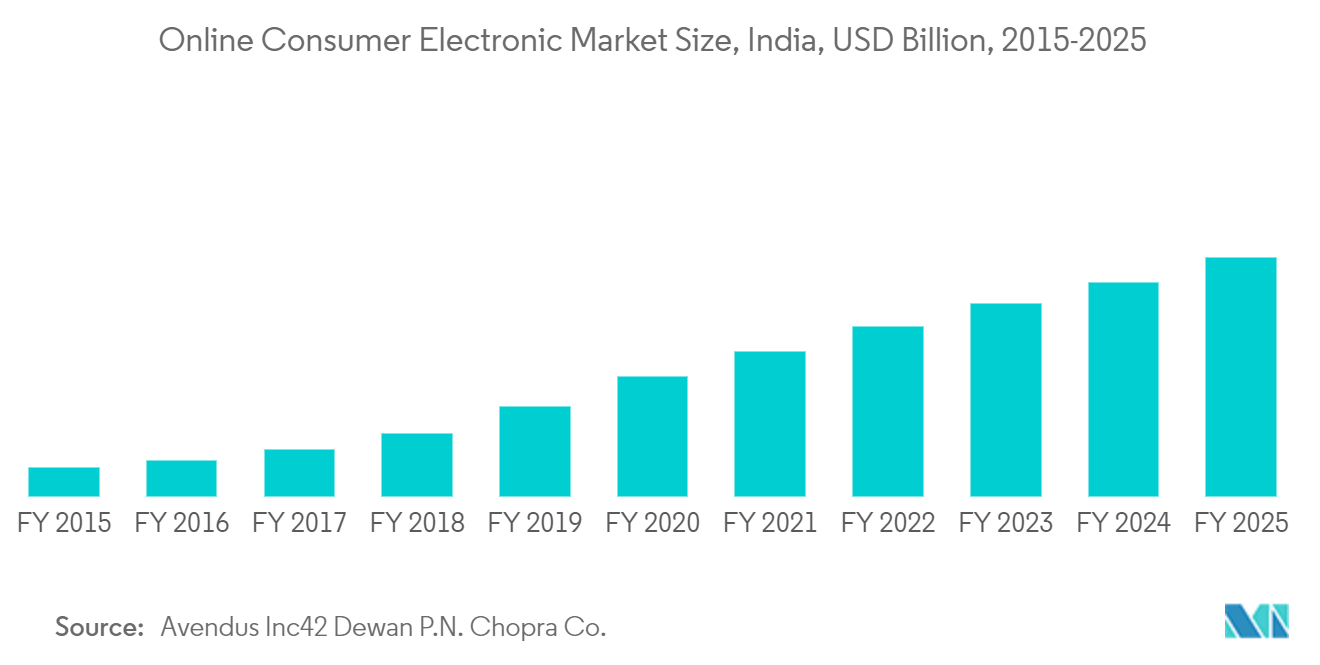
India E-Commerce Industry Overview
In India, the competition in the e-commerce market has increased as the customer's adoption of online sales channels has grown. An increase aids this growth in internet penetration. Brands such as Amazon, Flipkart, and many more expand their reach by providing customer-centric services that enhance customers' online shopping experience.
- September 2023 - Walmart has spent USD 3.5 billion this year to increase its stake in the Indian business Flipkart to 80.5%, underlining the aggressive bets the United States-based retailer is making in the country, which it counts as one of its key markets.
- August 2023 -Walmart opens a new tab. It has paid USD 1.4 billion to buy out hedge fund Tiger Global's investment in its Indian e-commerce firm Flipkart and acquired private equity firm Accel's remaining 1% stake.
India E-Commerce Market Leaders
-
Amazon.com, Inc.
-
Flipkart Private Limited
-
eBay, Inc.
-
Alibaba Group Holding Limited
-
FSN E-Commerce Ventures Limited (Nykaa)
*Disclaimer: Major Players sorted in no particular order
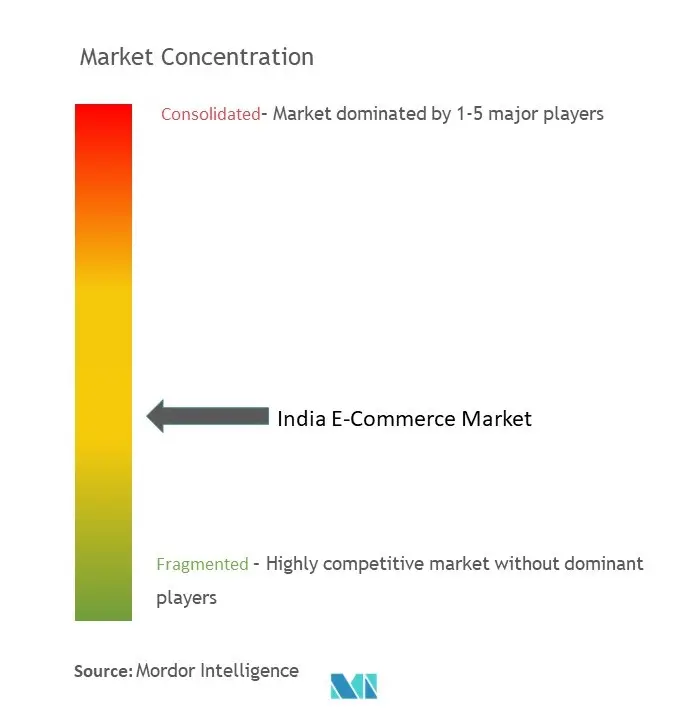
India E-Commerce Market News
- June 2023 - American tech giant Amazon has committed to investing an additional USD 15 billion in India over the next seven years. This will take the company’s total India investment across all businesses to USD 26 billion. Amazon has already invested USD 11 billion in India. The company has pledged to digitize 10 million small businesses, enable USD 20 billion in exports, and create two million jobs in India by 2025.
- January 2023 - Ecommerce major Flipkart’s Singapore-based parent has invested INR 722 Cr (USD 90 Mn) in its Indian marketplace arm. The fresh capital was raised from two entities – Flipkart Marketplace Private Limited and Flipkart Private Limited, which are domiciled in Singapore.
India E-Commerce Market Report - Table of Contents
1. INTRODUCTION
- 1.1 Study Assumptions and Market Definitions
- 1.2 Scope of the Study
2. RESEARCH METHODOLOGY
3. EXECUTIVE SUMMARY
4. MARKET INSIGHTS
- 4.1 Market Overview
-
4.2 Industry Attractiveness-Porter's Five Forces Analysis
- 4.2.1 Bargaining Power of Suppliers
- 4.2.2 Bargaining Power of Buyers/Consumers
- 4.2.3 Threat of New Entrants
- 4.2.4 Threat of Substitute Products
- 4.2.5 Intensity of Competitive Rivalry
- 4.3 Key Market Trends and Share of E-commerce of Total Retail Sector
- 4.4 Impact of COVID-19 on the E-commerce Sales
5. MARKET DYNAMICS
-
5.1 Market Drivers
- 5.1.1 Increased Internet Penetration Across the Country
- 5.1.2 Supportive Government Policies and Regulatory Framework
-
5.2 Market Challenges
- 5.2.1 High Rate of Return of Merchandise, Especially in B2C Segment
- 5.3 Analysis of Key Demographic Trends and Patterns Related to E-commerce Industry in India (Coverage to include Population, Internet Penetration, E-commerce Penetration, Age and Income, etc.)
- 5.4 Analysis of the Key Modes of Transaction in the E-commerce Industry in India (Coverage to Include Prevalent Modes of Payment, such as Cash, Card, Bank Transfer, and Wallets)
- 5.5 Analysis of Cross-border E-commerce Industry in India (Current Market Value of Cross-border and Key Trends)
- 5.6 Current Positioning of India in the E-commerce Industry in Asia-Pacific
6. Market Segmentation
-
6.1 By B2C E-commerce
- 6.1.1 Market Size (GMV) for the Period of 2018-2028
- 6.1.2 Market Segmentation - by Application
- 6.1.2.1 Beauty and Personal Care
- 6.1.2.2 Consumer Electronics
- 6.1.2.3 Fashion and Apparel
- 6.1.2.4 Food and Beverage
- 6.1.2.5 Furniture and Home
- 6.1.2.6 Other Applications (Toys, DIY, Media, Etc.)
-
6.2 By B2B E-commerce
- 6.2.1 Market Size for the Period of 2018-2028
7. Competitive Landscape
-
7.1 Company Profiles
- 7.1.1 Amazon.com Inc.
- 7.1.2 Flipkart Private Limited
- 7.1.3 eBay Inc.
- 7.1.4 Alibaba Group Holding Limited
- 7.1.5 Nykaa
- 7.1.6 Snapdeal
- 7.1.7 Ajio
- 7.1.8 Grofers
- 7.1.9 Purplle
- 7.1.10 Apple Inc.
- *List Not Exhaustive
8. INVESTMENT ANALYSIS
9. FUTURE OF THE MARKET
** Subject To AvailablityIndia E-Commerce Industry Segmentation
E-commerce is the buying and selling of goods and services over the Internet through online shopping. However, this term is often used to describe all the seller's efforts in selling products directly to consumers. It begins when potential customers learn about a product, buy it, use it, and ideally maintain lasting customer loyalty.
The Indian e-commerce market is segmented into B2C E-commerce (beauty and personal care, consumer electronics, fashion and apparel, food and beverage, furniture, and home) and B2B E-commerce. The report's scope includes market size and forecasting for B2B and B2C segments, with the B2C channel being further split by application. The market sizes and forecasts are provided in terms of value (USD) for all the above segments.
| By B2C E-commerce | Market Size (GMV) for the Period of 2018-2028 | |
| Market Segmentation - by Application | Beauty and Personal Care | |
| Consumer Electronics | ||
| Fashion and Apparel | ||
| Food and Beverage | ||
| Furniture and Home | ||
| Other Applications (Toys, DIY, Media, Etc.) | ||
| By B2B E-commerce | Market Size for the Period of 2018-2028 |
India E-Commerce Market Research FAQs
How big is the India E-Commerce Market?
The India E-Commerce Market size is expected to reach USD 112.93 billion in 2024 and grow at a CAGR of 21.5% to reach USD 299.01 billion by 2029.
What is the current India E-Commerce Market size?
In 2024, the India E-Commerce Market size is expected to reach USD 112.93 billion.
Who are the key players in India E-Commerce Market?
Amazon.com, Inc., Flipkart Private Limited, eBay, Inc., Alibaba Group Holding Limited and FSN E-Commerce Ventures Limited (Nykaa) are the major companies operating in the India E-Commerce Market.
What years does this India E-Commerce Market cover, and what was the market size in 2023?
In 2023, the India E-Commerce Market size was estimated at USD 88.65 billion. The report covers the India E-Commerce Market historical market size for years: 2019, 2020, 2021, 2022 and 2023. The report also forecasts the India E-Commerce Market size for years: 2024, 2025, 2026, 2027, 2028 and 2029.
What are the future trends expected to shape the India E-Commerce Market?
Future trends in the India Ecommerce Market include: a) Rise of omnichannel retail b) Growth of sustainable and ethical brands online c) Increased use of Artificial Intelligence & Augmented Reality for personalized shopping experiences
What are the major factors driving the growth of the India E Commerce Market?
The major factors driving the growth of India E-commerce industry are: a) Rapid urbanization b) Increased Internet Penetration Across the Country c) Growing use of devices such as smartphones
E-Commerce in India Industry Report
The Ecommerce Market in India is experiencing unprecedented growth, transforming into a dynamic sector due to a vast population, increasing internet penetration, and a thriving digital ecosystem. Government initiatives promoting foreign direct investment and support for small and medium-sized enterprises (SMEs), alongside a diversification in commerce segments, have broadened the ecommerce landscape.
The pandemic has accelerated online shopping adoption, especially in tier 2 and tier 3 cities, diversifying product categories and boosting the ecommerce market share in India. Leveraging data analytics, artificial intelligence (AI), and machine learning (ML), the sector is enhancing customer experiences with personalized recommendations, while quick commerce meets demands for rapid delivery.
Significant market segments include home appliances, consumer electronics, and fashion, contributing to the vibrant competitive landscape. With continuous innovation and strategic initiatives, the Indian ecommerce market, supported by technological advancements and changing consumer behaviors, is on a robust growth trajectory, positioning itself as a key player globally.
For detailed insights, Mordor Intelligence™ offers a comprehensive analysis, including market share, size, and revenue growth rate, with a free report PDF download available for a deeper understanding of the ecommerce landscape in India. The report covers industry trends, industry growth, industry statistics, market size, market share, growth statistics, global market, growth rate, market research, industry report, market growth, sector analysis, industry size, industry analysis, analysis report, market analysis, industry worth, sales data, market cap, sales forecast, market report, market value, industry overview, market segmentation, market data, industry outlook, growth forecast, target market, market statistics, industry value, industry pdf, market forecast, market leaders, market overview, revenue statistics, market outlook, largest companies, market trends, analysis example, analysis pdf, consumer market, global industry, industry forecast, industry information, industry sales, profile pdf, research analysis, research company, size global, annual report, industry data, industry profile, industry research, industry revenue, industry trend, market reports, market structure, market trend, industry reports, market predictions, market review, market segments, research companies.



